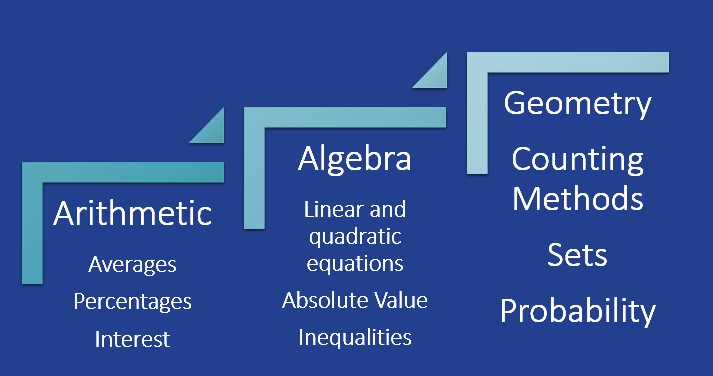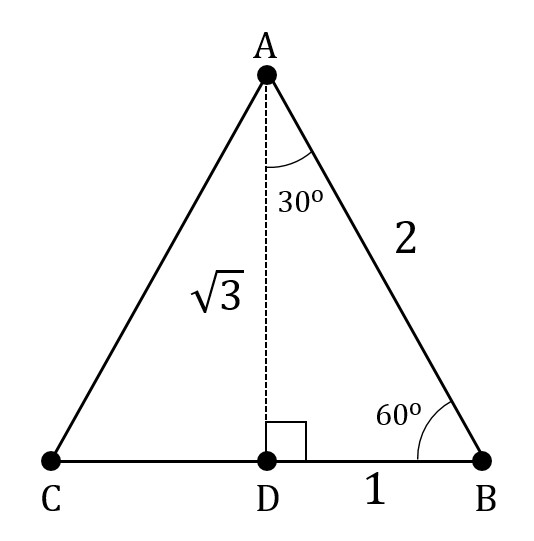GMAT Math Review

Key Topics in this GMAT Math Review
In this GMAT math review, we will review GMAT arithmetic and algebra, linear and quadratic equations, number properties, population statistics, basic set theory, geometry, and counting methods including permutation and combination.
We cover exactly what you need to know for the GMAT Quantitative section. The “exactness” is possible because the math that is required for the GMAT is defined by the test-maker in official language describing the GMAT.
Resources other than GMAT Free can be quite helpful in the review process. For example, the Open Math Reference has dynamic elements that you can play with, such as this page showing basic triangle properties. However, other resources will generally contain many things you don’t need to know, and they will omit some things that you need to know. To stay focused, Google and use other resources, but make this module your syllabus.
The upshot is that, for the Quantitative section of the GMAT, “all” you have to do is master the topics in this book – and then practice using that knowledge to solve questions. You will not see a Quant question on the GMAT of any difficulty level that requires some piece of mathematical knowledge not in these pages.
That can be a pretty inspiring fact. It means, whether or not you like mathematics, there is a well-defined task. Putting in effort and time is going to pay off.
A Lightning Overview of the Topics in This Math Review
Many people laugh when they hear this, but the GMAT is designed to require minimal mathematical knowledge. One objective of the GMAT is to employ only mathematics that everyone who is applying to business school has had an opportunity to learn – namely, high school mathematics. That’s why geometry and other topics that are relatively irrelevant to business school are included on the GMAT.
The subject areas that are tested on the GMAT break down into a couple basic categories.
The first is arithmetic. On the GMAT, arithmetic includes the ability to work with fractions, to multiply and divide, to estimate and round numbers, and to work with units.
We can also lump into the arithmetic category some snippets of mathematics that really belong to other branches. For example, you’ll have to deal with number properties. For many people, the phrase “number properties” is foreign, but it does not have to be intimidating. “Number properties” questions will ask you about even and numbers, positive and negative numbers. To answer these questions, you will use rules that you don’t use in everyday life but which are not difficult and which we will cover entirely in this book.

Performing basic computations and using formulas is important for GMAT math. This formula gives a quick way to calculate a percent increase of x followed by a percent decrease of x.
Furthermore, arithmetic will require that we know some statistics. On the GMAT, you will employ much less statistical knowledge then you will use in business school. Mostly you’ll be working with different types of averages on the GMAT. You will want to have some knowledge of standard deviation for the GMAT, and we’ll discuss exactly what that is in this book.
The second big category of mathematical knowledge on the test is algebra. Algebra involves working with variables. This, for many people, is the least favorite part of the exam: having to “solve for x.” However, we’ll cover exactly what you need to know for the GMAT in this book when it comes to algebra. And the good news is that there are many subjects you studied in junior high and high school that you do not need to know for the GMAT. You won’t need to know any trigonometry, for example. And no calculus! Mostly, you’ll need to know how to work with algebraic expressions, how to solve linear equations and quadratic equations, and how to graph lines and work in the coordinate plane. We’ll cover it all in these pages.
The third major category is geometry. Once again, there’s a lot of geometry that you have probably learned in your life that you won’t need to know for the GMAT. The geometry that you need to know for the GMAT is specifically defined.

The geometry that you need to review for the GMAT consists of a clearly defined set of rules and properties, which you then have to practice applying and using in unexpected ways. For example, this image combines two kinds of “special” triangle that we must know for the GMAT — one is nestled inside the other.
You’ll need to know about quadrilaterals, you need to know quite a bit about triangles, you’ll need to know circle properties… and there are a few other miscellaneous facts, such as the area of a trapezoid, the angles of a polygon and so forth that you’ll need to have at your disposal to solve these questions. From there the only challenge is how an individual question is going to put these elements together. But you won’t have to reach back in your forgotten memories and hope that there’s some random geometric fact in there that you’ll need to know for the question.
We’ll start with the very basics. Feel free to skip topics or go straight to the questions at the end of the chapters, which are links to practice questions in our free online course, GMAT Free. When you want realistic GMAT practice questions, head to the main page of the course and try Problem Solving and the other kinds of questions.
References/Reuse
If you happen to be an educator, note that you can modify and reuse much of the content in this book, which itself draws on the efforts of various Creative Commons sources. For more information, see “Sources, Copyright, and Reuse” near the end of this module.
Let’s get started! I’ll see you on the other side.